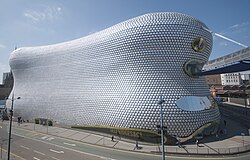Blobject    A blobject is a design product, often a brightly-coloured household object which has smooth curves and no sharp edges. The word is a portmanteau of "blob" and "object". Blobjects can be made of any material in any size or scale for the home, office, car, or outdoors. Common materials used in fabricating blobjects are plastic (especially polycarbonate, polypropylene, or polyethylene), metal, and rubber, with the aim being to give a more organic and animate feel. EtymologyThe origin of the term is disputed, but it is often attributed to either the designer-author Steven Skov Holt[1] or the designer Karim Rashid. Holt has defined a blobject as a colorful, mass-produced, plastic-based, emotionally-engaging consumer product with a curvilinear, flowing shape. This fluid and curvaceous form is the blobject's most distinctive feature. Rashid, the contemporary designer who wrote the book I Want to Change the World, was an early leader in creating blobjects and has become one of the most celebrated designers of his generation. OverviewWhile often viewed as a modern concept, Blobject can be traced all the way back to prehistoric sculptures like Venus of Willendorf. In the early 20th century, in the work of Joan Miró and Jean Arp, these characteristics appeared. After World War II, these design started appearing in home goods like La Chaise chair.[2] In the 1990s, designers like Philippe Starck, Marc Newson, and Karim Rashid led the way with the use of technology. Many of the most famous blobjects appeared in this decade.[3] Blobjects can also be found in most areas of contemporary visual culture.[2] A blobject can be a typeface (cf. Neville Brody), an animation (cf. Monica Peon), a piece of furniture (Marc Newson), an article of clothing (Rei Kawakubo), a motorcycle (GK Dynamics), a car (GEMCAR), a building (Future Systems), a painting (Rex Ray), a piece of sculpture (Hadeki Matsumoto), or ceramics work (Ken Price). The blobject trend has largely been driven by advances in computer-aided design, information visualization, rapid prototyping, materials, and injection molding. These technologies have given designers the chance to use new shapes and to explore transparency and translucency without significant extra production costs. See alsoReferences
Further reading
External links |













